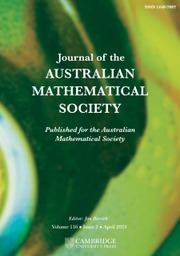Article contents
On zero-sum turan problems of Bialostocki and Dierker
Published online by Cambridge University Press: 09 April 2009
Abstract
Assume G is a graph with m edges. By T(n, G) we denote the classical Turan number, namely, the maximum possible number of edges in a graph H on n vertices without a copy of G. Similarly if G is a family of graphs then H does not have a copy of any member of the family. A Zk-colouring of a graph G is a colouring of the edges of G by Zk, the additive group of integers modulo k, avoiding a copy of a given graph H, for which the sum of the values on its edges is 0 (mod k). By the Zero-Sum Turan number, denoted T(n, G, Zk), k¦m, we mean the maximum number of edges in a Zk-colouring of a graph on n vertices that contains no zero-sum (mod k) copy of G. Here we mainly solve two problems of Bialostocki and Dierker [6].
Problem 1. Determine T(n, tK2, Zk) for ¦|t. In particular, is it true that T(n, tK2, Zk) = T(n, (t+k-1)K2)?
Problem 2. Does there exist a constant c(t, k) such that T(n, Ft, Zk) ≦ c(t, k)n, where Ft is the family of cycles of length at least t?
MSC classification
- Type
- Research Article
- Information
- Journal of the Australian Mathematical Society , Volume 53 , Issue 3 , December 1992 , pp. 402 - 407
- Copyright
- Copyright © Australian Mathematical Society 1992
References
- 3
- Cited by


